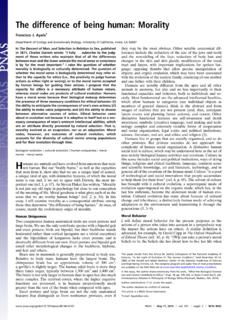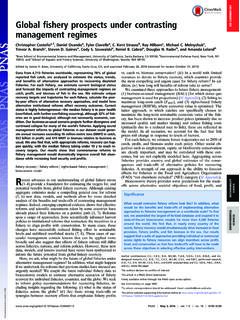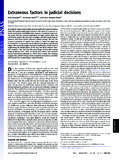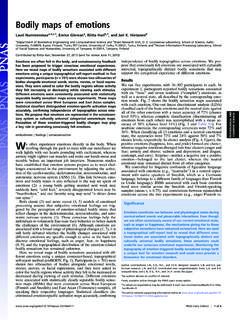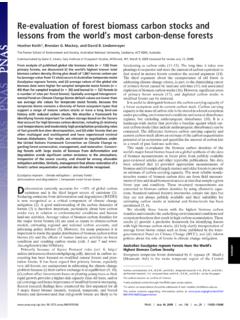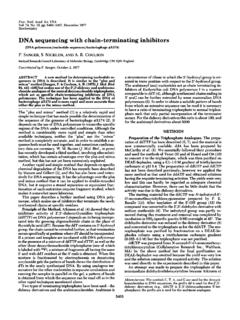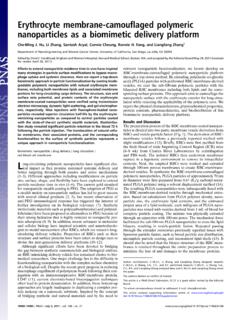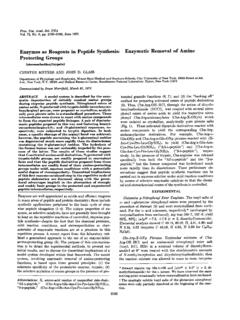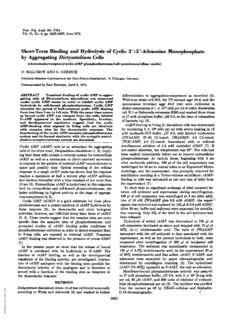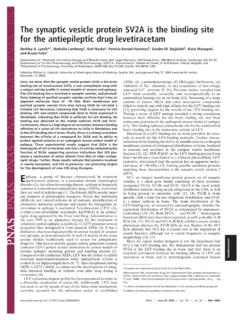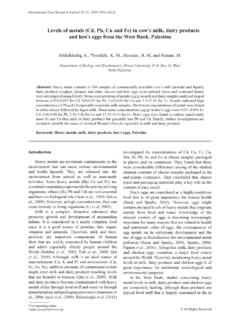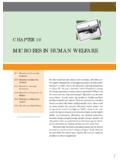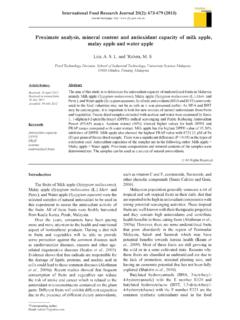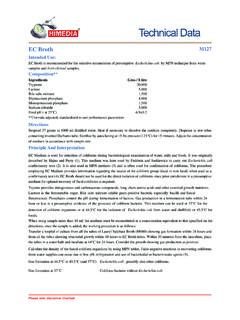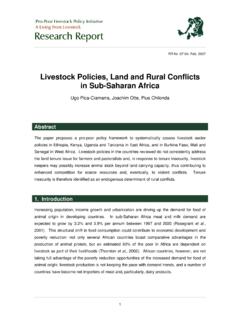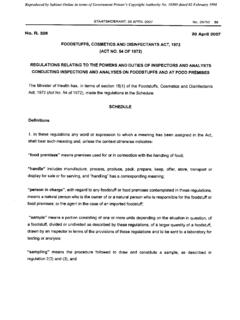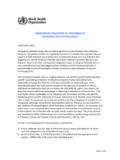Transcription of Supporting Information - pnas.org
1 Supporting InformationPastorelli et al. Materials and endoscopic biopsies from males and females,aged 18 65 yr, and affected by CD or UC and noninflamed CONwere harvested from patients undergoingflexible sigmoidoscopyor colonoscopy for diagnostic or surveillance purposes at theUniversity of Virginia Digestive Health Center (UVA DHC) andwere used for total RNA and protein extraction. Similar gender-and age-matched colonic surgical specimens were obtained fromeither UC or CD patients, as well as noninflammatory CON, whowere admitted to the UVA DHC or the Cleveland Clinic Foun-dation (CCF) and underwent therapeutic bowel resection for in-flammatory disease or for malignant and other nonmalignantnoninflammatory conditions. Full-thickness colon tissues wereused for IHC (UVA) and as a source for mucosal IEC and LPMC(CCF).
2 Anonymous unstained slides from infectious colitis anddiverticulitis patients were obtained as formalin-fixed, paraffin-embedded endoscopic biopsies or surgical specimens from theUVA Biorepository and Tissue Research Facility. Whole bloodsamples were collected from UC and CD patients who underwentmedical visits at the UVA DHC (disease activity study), theGastroenterology and Endoscopy Unit of IRCCS FondazioneMangiagalli, Regina Elena and Ospedale Maggiore of Milan andthe Gastroenterology and Endoscopy Unit of IRCCS PoliclinicoSan Donato for diagnosis, follow-up, and reactivation of IBD(disease activity and anti-TNF studies); age-, gender- and ethni-cally- matched healthy individuals were used as CON. Wholeblood samples were collected from UC and CD patients treatedwith Infliximab (5-10 mg/kg, ) 1 h prior and 2 h after each in-fusion at T0, and 2, 6, 14, 22, 30, and 38 wks.
3 All diagnoses wereconfirmed by clinical, macroscopic, and histologic criteria. Allstudies were approved by the Internal Review Board of the UVAH ealth System, CCF, IRCCS Fondazione Mangiagalli, ReginaElena and Ospedale Maggiore of Milan and IRCCS PoliclinicoSan (SAMP) and AKR/J (AKR) mice weremaintained under SPF conditions in the Animal Resource CoreFacility of Case Western Reserve University. All protocols wereapproved by the Institutional Animal Care and Use Committee(IACUC) of Case Western Reserve Harvest and Histologic Assessment of SAMP were removed from mice, rinsed with cold PBS, openedlongitudinally, and submerged in Bouin s solution (LabChem).Fixed tissues were processed, paraffin-embedded, sectioned at4 m, stained with H&E, and resulting ileal sections were histo-logically evaluated by a single pathologist in a blinded fashion,using a validated semiquantitative scoring system as described (1).
4 Isolation and Culture of MLN and Spleen and spleenswere collected from experimental mice and processed for cellisolation as described (1); briefly, organs were aseptically re-moved and passed through a 70- m cell strainer to obtain singlecell suspensions. Lysis of erythrocytes was performed with ACKlysis buffer (Lonza). Resulting cells were cultured in RPMI medium 1640 with 10% FBS and 1% penicillin/streptomycin, inthe presence of immobilized anti-CD3 (5 g/mL) and solubleanti-CD28 (1 g/mL) with or without rmIL-33 (10 ng/mL) for 48h. Supernatants were subsequently collected for further and Mouse Serum blood was drawn (5 mL)from patients by using a 22-gauge syringe into purple-toppedvaccutainers and from anesthetized mice by cardiac puncture,and centrifuged at 2,500 gfor 20 min.
5 Serum was collectedfrom each sample, immediately aliquoted, and stored at 80 Cuntil further of IEC and human IEC, colonic tissues werecollected and processed immediately after surgical resection asdescribed (2). Briefly, specimens were opened longitudinally,rinsed, examined for gross morphological changes, and repre-sentative full-thickness samples were obtained. Intestinal mucosawas stripped from the muscularis mucosa, cut into strips, andfreed of mucus by sequential washes in HBSS containing 10 mMDTT (Sigma-Aldrich). IEC were isolated by repeated incu-bations in HBSS (Invitrogen/GIBCO) containing 1 mM EDTA(Sigma-Aldrich). Mononuclear, red blood, and dead cells wereremoved by using a 40% Percoll Plus gradient (GE Healthcare),where IEC equilibrated at the interface; resulting preparationsenriched for IEC were collected, washed twice in PBS, andsubsequently counted.
6 Using an immunoperoxidase method, allcells with epithelial morphology were stained with anti-keratinmAb, with<1% contaminating LPMC, as assessed by stainingwith a monoclonal antibody directed against a leukocyte com-mon Ag (CD45). For human LPMC, stripped mucosa, freed ofmucus and IEC, was digested overnight with collagenase andDNase (both from ThermoScientific). The resulting crude cellsuspensions were purified by using a Ficoll-Hypaque Plus gra-dient (GE Healthcare), and the preparations were preferentiallyenriched for LPMC, washed, and from experimental mice were isolated as described (3);briefly, mouse ileal segments were minced into 1-cm pieces andrepeatedly incubated in a solution containing 1 mM EDTA(Sigma-Aldrich) with vigorous shaking.
7 Contaminating cells wereremoved by using a 40% Percoll Plus gradient (GE Healthcare),and purity was from UC mucosa were used forflowcytometric analysis. Cell suspensions were prepared in PBScontaining 2% FBS. Cells (106) were stained with appropriatecombinations of FITC-, PE-, and Pacific Blue-labeled mouseanti-human CD4 (RPA-T4), CD8 (HIT8a), CD11b (ICRF44)(BD Pharmingen), and CD68 eBioY1/82A (Y1/82A) (eBio-sciences). Polyclonal goat anti-human IL-33 IgG (AF3625) andpolyclonal goat anti-human ST2 IgG (AF523) (R&D Systems)were used in combination with donkey anti-goat IgG FITC- andAPC-labeled secondary antibodies (F0108 and F0109) (R&DSystems). Intracellular staining for IL-33 was performed ac-cording to eBioscience permeabilization buffer kit cytometric analysis was performed by using a BD LSRII based on BD FACS diva software (Becton Dickinson).
8 Cell HT-29 intestinal epithelial cancer cell line(ATCC) was grown to 80% confluency in RPMI medium 1640media, supplemented with 10% FBS and 2% penicillin/strepto-myocin (all from Invitrogen/GIBCO), and cultured with orwithout rhTNF (10 ng/mL; Peprotech) for 0, 2, 6, 12, 24, and 48 were immediately collected, aliquoted, and frozenat 20 C for later assays; cells were harvested for total RNA Extraction and Reverse bi-opsies, mouse ilea, and freshly isolated IEC were placed in RNAL ater (Applied Biosystems), left at 4 C overnight, then frozenand stored at 80 C. Total RNA was isolated by using thePastorelli et kit (Qiagen) and reverse-transcribed by using the Super-Script III kit (Invitrogen), both by manufacturers and Quantification of Total Protein pro-tein extracts were prepared from endoscopic biopsies, mouse ilea,freshly isolated IEC, and cultured HT-29 cells as described (2).
9 Briefly, samples were placed in RIPA lysis and extraction buffercontaining Halt protease and phosphatase inhibitor mixtures (allfrom Pierce Biotechnology), with biopsies homogenized for 30 sby using a Brinkmann hand-held polytron. Protein was also ex-tracted from cytoplasmic and nuclear cell fractions from HT-29cells, using NE-PER nuclear and cytoplasmic extraction reagents(Thermo Scientific), according to manufacturers and cell protein extracts were then centrifuged and im-mediately frozen at 20 C for later assays. Total protein ex-tracts were quantified by using a modification of the Bradfordcolorimetric procedure (Bio-Rad Protein Assay; Bio-Rad Lab-oratories).Quantification of ST2 and Cytokines Protein IL-33protein concentrations in patient serum and cell culture super-natants were measured by sandwich ELISA (Apotech), with a SLDof5pg/mL,orbythehuman IL-33 DuoSet (R&DSystems).
10 Serumand cell culture supernatant concentrations of human sST2 werealso measured by sandwich ELISA (Medical & Biological Labo-ratories; or ST2 Duo Set, R&D Systems), both with an SLD of 32pg/mL. Mouse serum IL-33 concentrations were measured bysandwich ELISA with the mouse IL-33 Duo Set (R&D Systems).All ELISAs were performed according to manufacturers in-structions. Cytokines in MLN and spleen cell culture supernatantswere measured with the Quansys multiplex ELISA array (QuansysBioscience), according to manufacturer s and ST2 of human IL-33 and ST2, sST2and ST2L and mouse IL-33 and ST2 mRNA transcripts relativeto human GAPDH and mouse -actin (housekeeping genes)was measured in endoscopic biopsies, mouse ileal tissue, andfreshly isolated IEC by using the following primers.
